1. Moving from World to EnterpriseOne
JD Edwards EnterpriseOne was originally called JD Edwards OneWorld and was originally designed to be the successor product to JD Edwards World. However, both product lines are part of Oracle’s Applications Unlimited strategy and receive ongoing investment and have roadmaps into the future.
History of JD Edwards World and EnterpriseOne

JD Edwards EnterpriseOne was originally called JD Edwards OneWorld and was originally designed to be the successor product to JD Edwards World. However, both product lines are part of Oracle’s Applications Unlimited strategy and receive ongoing investment and have roadmaps into the future.
A current list of possible World to EnterpriseOne migration paths are shown below:

The critical steps in planning and executing a successful World to EnterpriseOne Migration at a high level can be summarized as:
Planning:
- Building the Business Case
- Determining the Type of Migration
- Initial High Level Project Planning
- Selecting a Partner
- Determining the Technology Architecture & Infrastructure
Execution
- Security
- Customizations
- Integrations
- Data
- Testing
- Training
1.1 Planning
Business Case
The initial step in the migration involves building your business case. The key drivers for the business case can typically be classified in one of a few categories:
- Business Drivers
- New modules, features, reporting, user interface, navigation,
- Technology Drivers
- Easier administration, easier upgrade, better development tools, 3rd party support, modern interface standards and tools, mobility, reporting, technology certifications
- Support Drivers
- Technology updates, tax & regulatory updates (ACA, FASSB, etc.)
Oracle offers a number of resources and references to aid customers in building their business case to migrate to EnterpriseOne:

To best prepare customers to migrate to EnterpriseOne, Syntax recommends that all customers attend a specialized version of a Syntax led ‘100 Day Upgrade Workshop’. This Oracle sponsored workshop and content is custom tuned by Syntax to address the unique concerns of World to EnterpriseOne Migrations. Syntax offers this workshop to large general audiences as well as on site at customer’s location (Contact your Syntax Account Executive for additional information).
Syntax offers a number of Functional and Technology assessments and planning workshops to guide World customers along the pathway to EnterpriseOne. Technical workshops include:
- E1 Infrastructure Assessment Planning & Design Workshop
- E1 CNC Assessment Planning & Design Workshop
- E1 Technology Upgrade/Migration Planning Workshop
- E1/World Object Customization Discovery Workshop
- E1 Reporting and Business Intelligence Assessment, Planning & Design Workshop
- E1 Data Archive & Purge Workshop
- E1 Security Assessment Workshop
- E1 Security Model Planning Workshop
- IBM System i (AS/400 Assessment Planning & Design Workshop
- Intel/VMWare & Storage Assessment, Planning & Design Workshop
- E1 Data Archive & Purge Workshop
- E1 Security Assessment Workshop
- E1 Security Model Planning Workshop
- IBM System i (AS/400) Assessment Planning & Design Workshop
- Intel, VMWare & Storage Assessment, Planning & Design Workshop
Migration Type
JD Edwards upgrades and migrations are typically classified according to the scope, time to compete, risk and cost. The diagram below illustrates the different categorizations of projects:
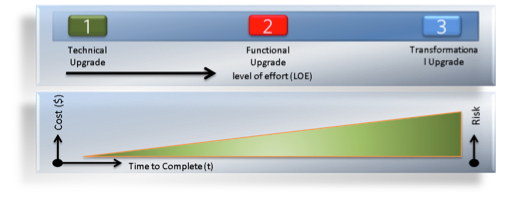
Due to the degree of change that is involved in the project. All World to EnterpriseOne migrations are transformational in nature. World to EnterpriseOne migrations discards all modifications and versions, discards all security and discards the majority of reports.
High Level Project Planning
Defining a high level project plan and charter and obtaining executive buy in is a critical step in the project success. Choose an executive sponsor that can threaten a pay check.
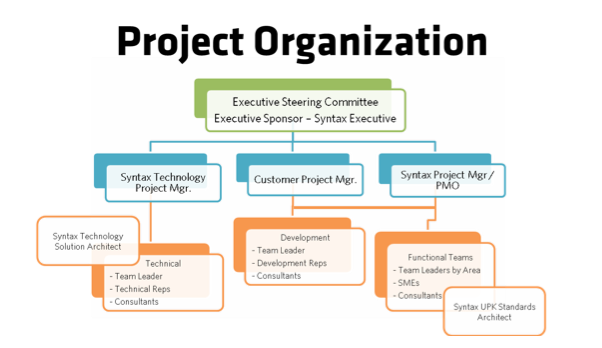
A clearly defined business case facilitates the requisite budget approval. To borrow a quote from the upgrade workshop, “If you have budget, then you have staff.”
Partner Selection
EnterpriseOne change management activities have varying degrees of skill requirements. World to EnterpriseOne Migrations require the highest levels of skills and competency.
Customers are advised to choose Oracle Platinum Level partners who specialize in JD Edwards EnterpriseOne and who can offer a one-stop-shop for Functional, Development, Technology, Infrastructure and Cloud. Also, since the bulk of the conversion activities run on the IBM System I, deep expertise on the platform is required, so customers should gravitate toward JD Edwards partners who are also IBM Premier Business Partners.
A proven track record of recent, net new EnterpriseOne installations is a key indicator of the partner’s ecosystem contributions and status within the community, while recent World Migration experience is a necessity when qualifying partners.
Technology Architecture & Infrastructure
Unlike World, EnterpriseOne requires technology from potentially multiple vendors. Customers must consider the architecture & topology, on premise or cloud deployment, operating system & database, middleware, storage and the overall system sizing.
The topology and architecture require consideration of the components being deployed such as Web Services, Mobility, UPK, OATS and others components. The overall business community strategy, which includes high availability and disaster recovery, are also key considerations.
Syntax’s previously described assessments and workshops can accelerate your architecture and infrastructure design, provide sizing and guide customers through the selection process:
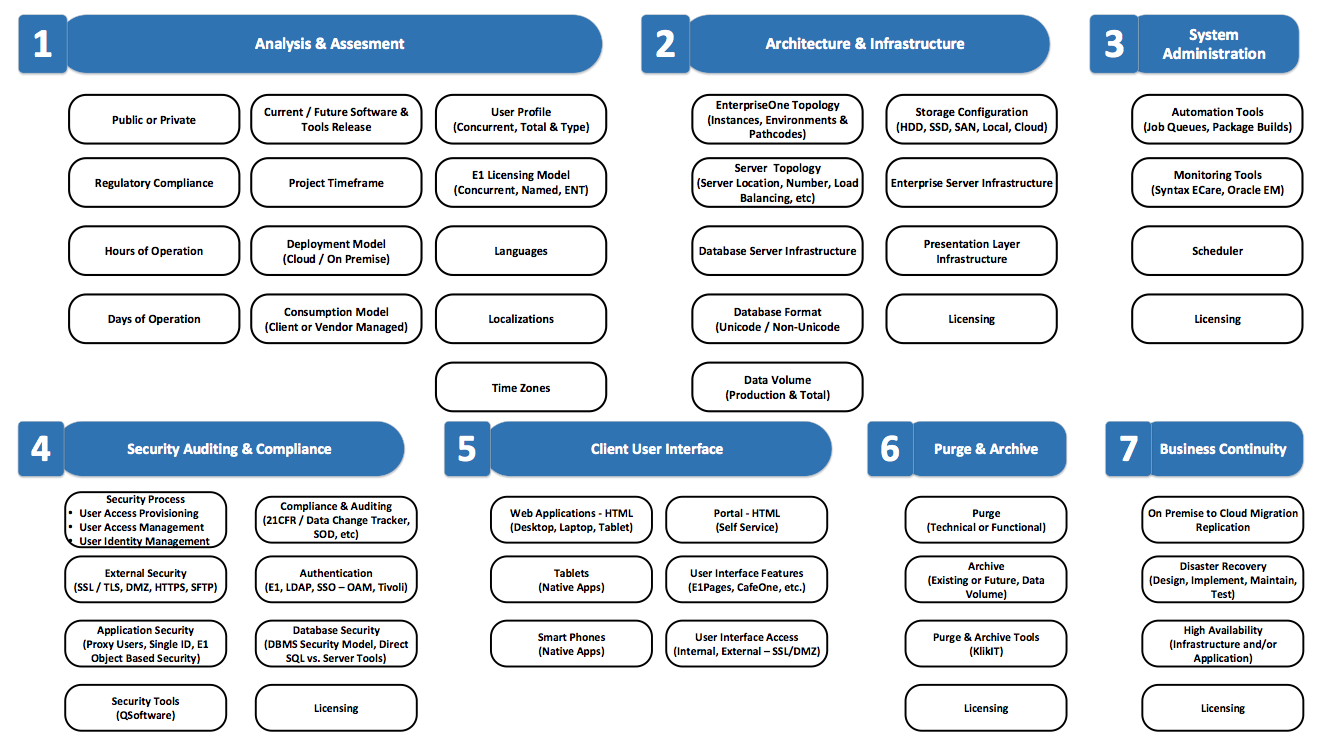
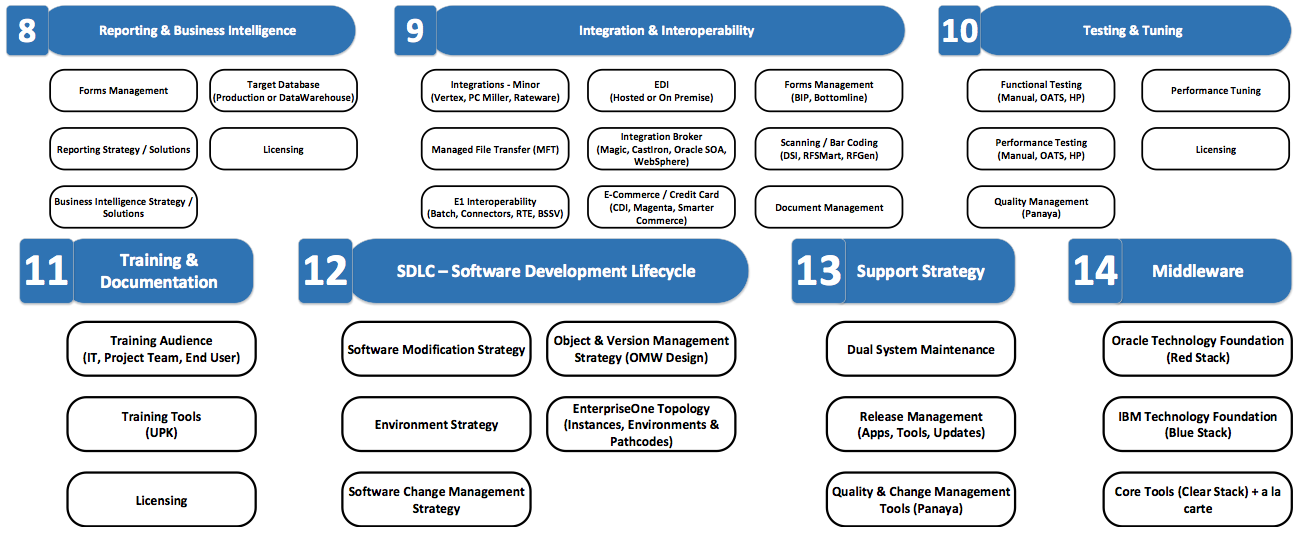
1.2 Execution
Security
World security does not migrate to EnterpriseOne so customers must undergo a completely new security implementation. Syntax offers pre-configured accelerator security templates to significantly shorten the security implementation. This can reduce the security sub-project from months to weeks.
Customers should consider regulatory requirements when re-implementing security along with segregation of duties. Syntax leverages QSoftware Audit Manager for improved compliance and audit.
Customizations
Moving to EnterpriseOne is an opportunity to de-customize as no World code moves to EnterpriseOne from World. Even versions need to be reconfigured and setup.
A World customization object discovery paired with a Syntax Functional fit gap analysis can identify those customizations that have been replaced by native EnterpriseOne functionality and those customizations that provide a key business differentiator and should be re-customized in EnterpriseOne. Customization should be minimized as each customization costs time and money on every future upgrade.
Integrations
EnterpriseOne offers a host of new possibilities for integrations and interoperability. Customers are encouraged to become educated early, and Syntax provides a range of workshops and templates in specific areas from the functional, development and technical viewpoints.
An inventory of all existing customizations in World followed by a determination of the ongoing requirement for the interfaces pairs down the scope. Moving to EnterpriseOne may introduce additional interface requirements and customers may need to consider the adaptations required for a Cloud deployment of EnterpriseOne or integration to cloud applications.
World customers remaining on the IBM System I may be able to reuse existing RPG interfaces with minimal effort or an upgrade to newer technology may be in order.
New interfaces should match the business needs and technology skill sets with the appropriate interoperability method.
Data
The conversion of data from World to EnterpriseOne is often a fear for many customers. The assumption is that large amounts of data increase the conversion timeframe and negatively affect system performance. Large data volumes are also a concern for Cloud migrations.
In reality large data volumes are a concern when migrating to another platform but a limited concern for customers remaining on the IBM System I. The bulk of the conversions run on the IBM System I are World conversions and are typically fast and efficient.
The process of moving to a different database and/or platform is a separate post migration step that can add a significant amount of time to the conversion process.
Although purge and archive can be useful, EnterpriseOne has a number of native features to deal with increasing data volumes. Additionally, most databases offer a form of compression, which improves performance by reducing I/O at the cost of higher CPU and memory usage.
For World migrations involving a platform and database change and/or a cloud migration, Syntax suggests a purge and archive process using Purge-It from Klik IT.
Depending on the complexity of the upgrade Syntax’s performs additional conversion optimization which may include:
- Customized EnterpriseOne Data Conversion Process
- Use custom SQL scripts to replace native processes
- Pre-convert historic data and merge
Overall the data conversion may comprise a number of required and optional steps which include:
- Archive and Purge
- Pre-Conversion Data Clean-Up
- Cloud Migration
- Database and O/S Upgrade
- World Upgrade
- World to EnterpriseOne Data Conversion
- EnterpriseOne Data Conversion
- Database Conversion
- Cloud Migration
- Go-Live
- Database Compression
- Archive & Purge – EnterpriseOne
For conversion testing customers are advised to perform multiple dry runs and to test with copies of World production data.
Syntax documents and times each conversion in detail and suggests a minimum of 2 full mock go-lives when migrating from World to EnterpriseOne.
Testing
Moving from World to EnterpriseOne is a transformational project in which only the data is maintained, thus testing a greater range of functionality is required.
Organizations will benefit form having clear business process flow documentation for use in establishing testing scenarios. Mechanisms to capture testing scenarios or “test scripts” include the Syntax Script Testing Template and Oracle User Productivity Kit.
There are also many types of testing to incorporate into your plan, including:

Prioritize the test cases before starting testing. Differentiate between tests that MUST succeed without any changes and which tests can be accepted with workarounds. Identify tests that are not critical and can be deferred until a later date.
It is essential to plan for performance and scalability tests in order to guarantee a good end user experience. Companies should evaluate testing automation tools and develop or deploy solutions for multiple locations and remote users.
Oracle Application Testing Suite (OATS) is a comprehensive automated suite for load, performance and script testing and can become a key differentiator in your ERP environment.
Training
Users moving from World to EnterpriseOne will already be familiar with the key JD Edwards concepts and knowledge. However, comprehensive training on the user interface and navigation, new reporting tools and mobility may all be required.
Training should include a refresher on existing functionality and business processes to ensure consistency across the organization. Syntax offers custom net change classes to highlight functional changes and new functionality. The training plan should consider:
- Hands on training
- Distributed training
- Regional concerns
- E-learning strategies
It is essential for organizations to adopt a training methodology and to define a training plan early. Syntax offers workshops in training methodology and advises that all organization consider Oracle User Productivity Kit (UPK)
Oracle User Productivity Kit (UPK) is an integrated software suite with full life cycle training tools supporting design to assessment. Customers who acquire UPK can leverage Syntax consultants as well as internal staff to assist with UPK topic creation and guidance on “end user” topics.
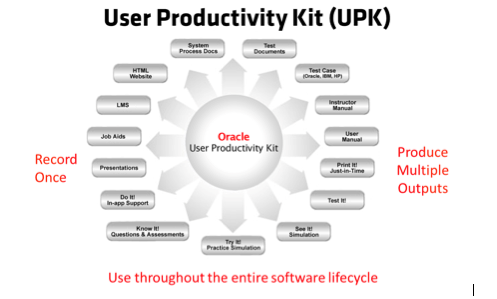
Summary
The driving factor in the decision to either remain on or upgrade World, or to migrate to EnterpriseOne should be matching business needs to the correct products. An in-depth understanding of the benefits of EnterpriseOne and the costs involved are the first steps in the migration planning process.
Customers should focus equally on the planning and execution phases and engage with Oracle Platinum Partners with a proven track record and history with the IBM System I, EnterpriseOne net new installations and World to EnterpriseOne migrations.
